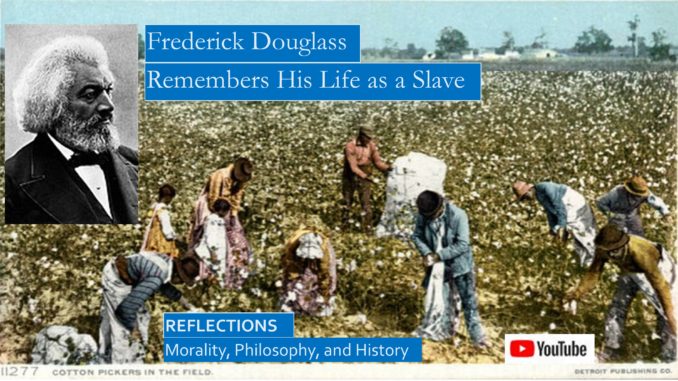
Frederick Douglas was born a slave in Maryland in the late 1820’s, he can only guess how old he is, like most slaves he did not know when he was born. He escaped slavery on his second attempt to run away to the Northern states, and not only did he teach himself how to read, he became a spell-binding orator and abolitionist, agitating for the end of slavery, and becoming a best-selling author, publishing three autobiographies, other books and a newspaper. Some bigots claimed it was impossible for an ex-slave to be able to write that well, though they could not argue that it was not him making his speeches.
This blog will review the first of these autobiographies covering his life as a slave, The Narrative of the Life of Frederick Douglas, and at a later time we will explore his third autobiography, Life and Times of Frederick Douglass, which also covers his life before, after, and during the Civil War.[1]
The third autobiography copies much of the first autobiography for its first section, except that the details of how he successfully escaped are not found in the earliest autobiography, since he did not want to endanger those slaves who had yet to escape to freedom, and those who helped them. Scanning these chapters looking for differences will be an interesting project. This third autobiography can also be read at:
https://archive.org/details/lifetimesoffrede1882doug/page/n7/mode/2up
Please view our YouTube video at https://youtu.be/7VkzhyNnuQk, it includes material, including a flashback from his third autobiography, that is not in the blog.
(Life and Times of Frederick Douglass includes his years as a slave, most of the earlier autobiography is nearly identical, except that he includes more details on how he successfully escaped slavery.)
Frederick was both a brilliant and a troublesome slave who had many masters before he escaped to freedom in his early twenties. His many masters included some of the most worse possible masters, and some of the least worse masters, we cannot say there are better masters, for that is an oxymoron. The upper south masters often quickly broke up their slave families, as younger slaves were valuable and selling slaves to the expanding plantations in Alabama and Mississippi was very profitable, since the international slave trade had been illegal since 1808.
For six months Frederick had been handed over to a slave breaker Master Covey, who had no slaves of his own but broke individual slaves through constant harassment and cruelty. After several months of this mistreatment, he got into a brawl with Master Covey that lasted several hours. If Master Covey had turned him in to the authorities he would have been executed, but then he would lose his reputation as a slave breaker and would no longer enjoy the free labor of troublesome slaves. They established an uneasy truce for the remaining time of his servitude with Mr. Covey, which meant that Frederick Douglass had broken the slave breaker.[2]
Some people thought that slaves were happy when they sang. Frederick knows this is not true, rather, “slaves sing most when they are unhappy. The songs of the slave represent the sorrows of his heart, and he is relieved by them, only as an aching heart is relieved by its tears.”[3] Likewise, if asked, a slave will tell you that his master is kind, for slaveowners are known to ask slaves to spy on what the other slaves are saying about the masters, so slaves assume that the walls have ears. Some slaves appeared to succumb to a Stockholm Syndrome, and competed with one another to brag how their master is the kindest master in the county.[4]
For this blog we will not try to track how Frederick came to be with this master or that, since we are mainly interested in what slavery was like and what his life as a slave was like.
BORN A SLAVE
As in Booker T Washington’s slave autobiography, Fredrick says that slaves are treated like talking livestock on the very first page, as he tells us that “most slaves know as little of their ages as horses know of theirs.” He tells us, “my father was a white man. . . The opinion was whispered that my master was my father, but of the correctness of this opinion I know nothing. . . My mother and I were separated when I was but an infant, before I knew her as my mother. It is a common custom in Maryland to part children from their mothers at an early age.” Often they would be raised by “an old slave woman, too old for field labor.” These slaveowners would be as quick to separate slave children from their parents as people give away puppies from their pet dog’s litter.
His mother’s owner lived a dozen miles away, he only saw her four or five times, and only at night. “My mother died when I was about seven years old. . . I was not allowed to be present during her illness, at her death, or burial. She was gone long before I knew anything about it. Never having enjoyed, to any considerable extent, her soothing presence, her tender and watchful care, I received the tidings of her death” as if she were a stranger.[5] He hints that sometimes slaves sometimes suffer from a Stockholm syndrome, a madness that causes them to insist that his master is the kindest master in the county.
CONDITIONS OF SLAVERY
Frederick gives us many instances of the constant and cruel whippings by cruel masters and overseers that were often random and arbitrary. One master, Mr. Plummer, was a “cruel man, hardened by a long life of slaveholding. He took great pleasure in whipping a slave. I have often been awakened at dawn by the most heart-rending shrieks of an aunt of mine, whom he used to tie up to a joist, and whip her naked back until she was covered with blood. . . The louder she screamed, the harder he whipped; where the blood ran fastest, there he whipped longest,” quitting only when he was overcome by fatigue.[6] He tells us of Mr. Hopkins, who liked to “whip slaves in advance of deserving it. He always managed to have one or more of his slaves to whip every Monday morning.”[7] Another overseer, Mr. Severe, and that was his name, once “whipped a woman, causing the blood to run half an hour at the time; and this, too, in the midst of her crying children, pleading for their mother’s release. He seemed to take pleasure in his fiendish barbarity.”[8]
Slaves were given meager rations of food and clothing. On his first farm the children were fed mush, which was “coarse corn meal. It was put into a large wooden tray or trough and set down upon the ground. The children were called, like so many pigs they would come and devour the mush. . . The child that ate fastest got most, he that was strongest got the best place; and few left the trough satisfied.”[9]
At the farms he worked on when he was young, “men and women slaves received, as their monthly ration, eight pounds of pork, or its equivalent in fish, and one bushel of corn meal. Their yearly clothing consisted of two coarse linen shirts, one pair of linen trousers, like the shirts, one jacket, one pair of winter trousers, made of coarse negro cloth, one pair of stockings, and one pair of shoes. . . The children unable to work had neither shoes, stocking, jackets, or trousers; their clothing consisted of two coarse linen shirts per year. When these wore out, they went naked until next allowance day,” even in the winter.”
Slaves were given no beds. Frederick tells us that at bedtime everyone, “old and young, male and female, married and single, drop down side by side, on one common bed, which was the cold, damp floor, each covering themselves with their miserable blankets.”[10]
Slaves were occasionally reminded they were considered as mere property, as chattel, such as when Frederick’s master died without a will. He remembered the valuation of the estate, “Men and women, old and young, married and single, were ranked with horses, sheep, and swine.” All were physically inspected, then the property was divided among the heirs. “Our fate for life was now to be decided. We had no more voice in that decision than the animals among whom we were ranked. A single word from the white man was enough, against all our wishes, prayers, and entreaties, to sunder forever from us our dearest friends, kindred, and the strongest ties known to human beings.” This was especially vexing as one of whites receiving an inheritance was known to be especially cruel.[11]
One slave’s fate in this property division was especially cruel, Frederick’s grandmother, “who had been the source of the wealth of the deceased master, she had peopled his plantation with slaves, she had rocked him in infancy, attended him in childhood, served him through life, and at his death wiped from his icy brow the cold death-sweat, and closed his eyes forever.” The ungrateful heirs “took her to the woods, built her a little hut, put up a little mud-chimney, and then made her welcome to the privilege of supporting herself there in perfect loneliness; thus, virtually turning her out to die!”[12]
Frederick reflects on how his slave master forced himself on to his slave mother. The freedom of the slave master to treat his female slaves as concubines, willing or not, is a feature of nearly all slave societies from the ancient world to the modern abolition of slavery. Frederick notes that when the master caters to his “own lusts, this makes gratification of their wicked desires profitable as well as pleasurable; for by this cunning engagement, the slaveholder, in cases not a few, sustains to his slaves the double relation of master and father.” These slave concubines were often a “constant offense to their mistress,” she likes to see them suffer under the lash, and often sells them off to be rid of them.[13]
Although slaves were often mistreated by their masters, rarely were they executed, because slaves were worth as much before the Civil Wars as economy cars are worth today, they were valuable property. But slaveowners were never brought to justice for killing a slave, and Frederick witnesses three occasions when a slave was murdered. One slave was shot for standing in a creek to avoid a harsh whipping. Another female slave was beat to death for falling asleep when she was tasked with looking after a baby. Yet another was shot for trespassing when hunting for oysters, since his master did not feed him enough.[14]
LIFE AS A CITY SLAVE, AND LITERACY
Frederick was delighted to be sent to Baltimore when he was about eight years old to be the servant of a relative, Mr. and Mrs. Auld, because he was able to clean up and was given a brand-new pair of trousers![15] Mrs. Auld had never owned a slave before. As Frederick tells us, prior to her marriage she worked for a living, and “to a good degree was preserved from the blighting and dehumanizing effects of slavery. I was utterly astonished at her goodness. I scarcely knew how to behave towards her. She was entirely unlike any other white woman I have ever seen.” She treated him like he was a fellow human being, and even started teaching him how to read until Frederick could spell out words of three and four letters, until Mr. Auld caught on to what was happening and put a stop to it. He scolded his wife, ‘If you give a nigger an inch, he will take a yard. A nigger should know nothing but to obey his master, to do as he is told. Learning would spoil the best nigger in the world. If you teach that nigger to read, there would be no keeping him. He would be forever unfit to be a slave, he would become unmanageable, and of no value to his master, and do him no good.” Did he not realize Frederick was listening to this? How stupid did he think his slave was? But the lessons stopped, and her kind heart hardened, and her “angelic face was replaced by the face of a demon.[16] But that was all the lessons he needed to start his path to literacy, now he knew the key to unlocking the puzzle of reading and writing. Sometimes when he was playing with the white children in the neighborhood, he would ask them to give him quick lessons.[17]
As he learned how to read the newspaper, he read about how the abolitionists were trying to abolish slavery. But he discovered that his master’s fears about his learning to read had some merit. He tells us, “I would at times feel that learning how to read had been a curse rather than a blessing. It had given me a view of my wretched condition, without the remedy. . . In moments of agony, I envied my fellow-slaves for their stupidity.”[18]
Frederick liked being a city slave, as he explains, “a city slave is almost a freeman, compared with a slave on a plantation. He is much better fed and clothed, and enjoys privileges unknown to the slave on a plantation. There is a vestige of decency, a sense of shame, that does much to curb and check those outbreaks of atrocious cruelty so common on plantations. . . Few are willing to gain the reputation of being a cruel master,” and does not want to be known as a master that did not give his slave enough to eat.[19]
CRUEL RELIGION OF THE HYPOCRITAL SLAVEHOLDERS
Frederick Douglas added an appendix to his autobiography when he was challenged for his criticisms of the hypocrisy of many white Christians:
“I mean strictly to apply (my criticisms) to the slave-holding religion of this land, and with no possible reference to Christianity proper; for, between the Christianity of this land, and the Christianity of Christ, I recognize the widest, possible difference, so wide, that to receive the one as good, pure, and holy, is of necessity to reject the other as bad, corrupt, and wicked. To be the friend of the one, is of necessity to be the enemy of the other. I love the pure, peaceable, and impartial Christianity of Christ: I therefore hate the corrupt, slave-holding, women-whipping, cradle-plundering, partial and hypocritical Christianity of this land.”[20]
We extend this quote from his appendix, and explore some examples in his autobiography of how hypocritical “Christian” slaveholders can be more cruel in this blog:
http://www.seekingvirtueandwisdom.com/american-evangelicals-civil-rights-and-republican-politics/
ESCAPE AND FREEDOM
In his first try, Frederick and some other slaves tried to escape in a canoe, but they were caught, spent time in slave prison, and were re-enslaved.[21] The second time he succeeded, he went to New York where the abolitionists told him he was not safe there, so he was sent on to New Bedford, Connecticut.
His observations of a society free of slavery resemble the observations made by Booker T Washington about the morally debilitating effects of slavery on both master and slave. These are Frederick Douglass’ first impressions when he walked the streets of New Bedford, Connecticut: “Almost everybody seemed to be at work, but noiselessly so, compared to what I had been accustomed to. . . I saw no whipping of men; but all seemed to go smoothly on. Every man appeared to understand his work, and went about it with a sober, yet cheerful earnestness. . . To me this looked exceedingly strange.”
Frederick continues his observations. Everything looked clean, new, and beautiful. I saw few or no dilapidated houses; no half-naked children and barefooted women, such as I had been accustomed to seeing. The people looked more able, stronger, healthier, and happier, than those of Maryland. I was for one made glad by a view of extreme wealth, without being saddened by seeing extreme poverty. But most astonishing was the condition of the colored people, a great many of whom were escaped slaves like me. I found many, who had not been seven years out of their chains, living in finer houses, and evidently enjoying more of the comforts of life, than the average slaveholder in Maryland.”[22]
Our blog on his autobiography after slavery:
http://www.seekingvirtueandwisdom.com/life-and-times-of-frederick-douglass-after-slavery-as-an-abolitionist/
[1] https://en.wikipedia.org/wiki/Frederick_Douglass
[2] Frederick Douglass, The Narrative of the Life of Frederick Douglas, Chapter 10, pp. 179-187.
[3] Frederick Douglass, The Narrative of the Life of Frederick Douglas, Chapter 2, p. 153.
[4] Frederick Douglass, The Narrative of the Life of Frederick Douglas, Chapter 3, p. 155-156.
[5] Frederick Douglass, The Narrative of the Life of Frederick Douglas, Chapter 1, pp. 146-147.
[6] Frederick Douglass, The Narrative of the Life of Frederick Douglas, Chapter 1, p. 148.
[7] Frederick Douglass, The Narrative of the Life of Frederick Douglas, Chapter 10, p. 189.
[8] Frederick Douglass, The Narrative of the Life of Frederick Douglas, Chapter 2, p. 151.
[9] Frederick Douglass, The Narrative of the Life of Frederick Douglas, Chapter 5, p. 160.
[10] Frederick Douglass, The Narrative of the Life of Frederick Douglas, Chapter 2, pp. 150-151.
[11] Frederick Douglass, The Narrative of the Life of Frederick Douglas, Chapter 8, p. 171.
[12] Frederick Douglass, The Narrative of the Life of Frederick Douglas, Chapter 8, pp. 172-173.
[13] Frederick Douglass, The Narrative of the Life of Frederick Douglas, Chapter 1, p. 147.
[14] Frederick Douglass, The Narrative of the Life of Frederick Douglas, Chapter 4, p. 158-159.
[15] Frederick Douglass, The Narrative of the Life of Frederick Douglas, Chapter 5, p. 160-161.
[16] Frederick Douglass, The Narrative of the Life of Frederick Douglas, Chapter 6, p. 163.
[17] Frederick Douglass, The Narrative of the Life of Frederick Douglas, Chapter 7, p. 167.
[18] Frederick Douglass, The Narrative of the Life of Frederick Douglas, Chapter 7, p. 168.
[19] Frederick Douglass, The Narrative of the Life of Frederick Douglas, Chapter 6, p. 164.
[20] Frederick Douglass, The Narrative of the Life of Frederick Douglas, Appendix, p. 210.
[21] Frederick Douglass, The Narrative of the Life of Frederick Douglas, Chapter 10, pp. 193-197.
[22] Frederick Douglass, The Narrative of the Life of Frederick Douglas, Chapter 10, p. 208.

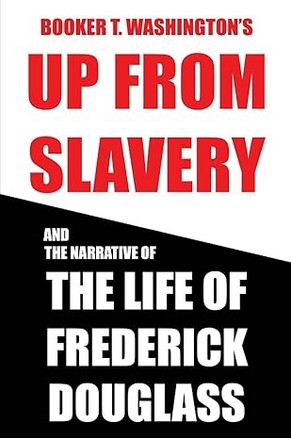
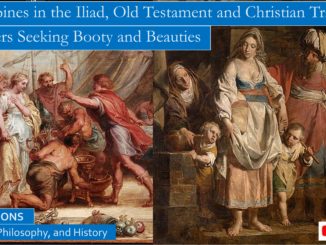
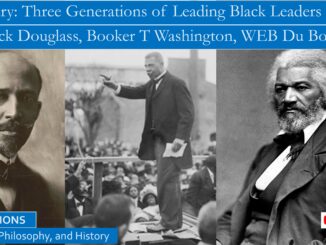
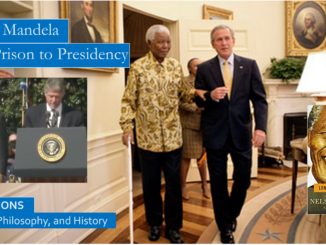
9 Trackbacks / Pingbacks